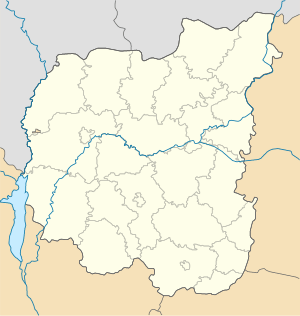Baturyn
| Baturyn Батурин | ||
|---|---|---|
| City of district signifance | ||
| ||
 Baturyn | ||
 Baturyn | ||
| Coordinates: 51°21′N 32°53′E / 51.350°N 32.883°E | ||
| Country | Ukraine | |
| Oblast | Chernihiv Oblast | |
| Raion | Bakhmach Raion | |
| Magdeburg rights | 1654 | |
| Area | ||
| • Total | 700 km2 (300 sq mi) | |
| Population | ||
| • Total | 3,066 | |
Baturyn (Ukrainian: Батурин) or Baturin (Russian: Бату́рин), is a historic town in the Chernihiv Oblast (province) of northern Ukraine. It is located in the Bakhmach Raion (district) on the banks of the Seym River. Baturyn lost its city status in 1923 and received it back only in 2008.
History
Evidence of settlement in the area of present-day Baturyn dates back to the Neolithic era, with Bronze Age and Scythian remains also having been unearthed. According to some modern writers, the earliest fortress at Baturyn would have been created by the Grand Principality of Chernihiv in the 11th century. The contemporary name for the settlement, however, was first mentioned in the 1625, likely referring to the fortress of Stefan Batory, King of Poland, Prince of Transylvania, and Grand Duke of Lithuania, which was built and named in his honor. The area had been part of the Polish-Lithuanian Commonwealth (in the Kijów Voivodeship of the Crown of Poland) since before the Union of Lublin. Control of the town was wrested from the Commonwealth during the Khmelnytsky Uprising, after which natives of Ruthenia gained some degree of autonomy under Hetman Bohdan Khmelnytsky and his Cossack state. In 1648, Baturyn was transformed into a Cossack regional center (sotnia), first hosting the Starodub Cossack Regiment, and then the Nizhyn Regiment.
By 1654, Baturyn, home to 486 cossacks and 274 villagers, was granted Magdeburg Rights. As the settlement grew, more merchants flocked to it, and great fairs were held quarterly. The capital of the Cossack Hetmanate, an autonomous Cossack republic in Left-bank Ukraine, was located in Baturyn from 1669–1708, and from 1750-1764. It was in Baturyn that Hetman Ivan Briukhovetsky signed the Baturyn Statutes in 1663, which further elaborated the treaty with the Tsardom of Russia which Khmelnytsky had initiated with the Treaty of Pereyaslav in 1654.
The area prospered under the rule of Hetman Ivan Mazepa (1687–1708), increasing in size and population (with upwards of 20,000 residents). Baturyn boasted 40 churches and chapels, two monasteries and a college for government officials and diplomats (the Kantseliarsky Kurin). In 1708, the Zaporozhian Cossacks were caught in the midst of the Great Northern War, in which Hetman Mazepa supported Sweden and its war with the Russian Empire and for Ukraine’s independence. On 13 November 1708, Baturyn was sacked and razed by the Russian army of Alexander Menshikov, and all of its inhabitants were slaughtered. Dmytro Chechel, the commanding officer of the Baturin garrison, was broken on the wheel. Historian Serhiy Pavlenko estimates that 6-7.5 thousand civilians and 5-6.5 thousand military personnel were murdered.[1] The population of the city in 1708 was 20,000. By 1726 the city was a ghost town.

The town was rebuilt in the 1750s, and served as the capital for Hetman Count Kirill Razumovsky, whose palace was designed by Andrey Kvasov in the Baroque style (later rebuilt in the Neoclassical style by Charles Cameron in 1799-1803). The home of the famous Cossack Vasily Kochubey, which was constructed some 50 years earlier, is surrounded today by a park in his name (although this building was devastated during World War II, it was restored during Soviet times).
Following Hetman Razumovsky's death, the town lost most of its political stature. In 1756, a textile plant was founded with 12 weaving machines, but quickly grew to include 76 machines. When Russian empress Catherine II abolished the Ukrainian Cossack state and incorporated its territories into the Russian Empire, Baturyn continued manufacturing textiles, feeding a growing demand for carpets. In 1843, Taras Shevchenko stayed in the town, marking his time by painting many of the architectural sights.
In June 1993, the Ukrainian government declared Baturyn the center of a national site of Ukrainian history and culture. In August, 2002, at the prodding of President Viktor Yushchenko, a government program was approved to restore Baturyn to its former glory.
On 22 January 2009, Ukraine's President Viktor Yushchenko officially opened the "Hetmans' Capital" Monumental complex with the newly renovated Razumovsky Palace.[2]
See also
References
- (Ukrainian) (1972) Icтopia мicт i ciл Укpaїнcькoї CCP - Чернiгiвськa область (History of Towns and Villages of the Ukrainian SSR - Chernihiv Oblast), Kiev.
- ↑ Павленко С. Загибель Батурина. К. 2007 p. 252
- ↑ Revival of Baturyn important step in restoring national dignity, says president, Interfax-Ukraine (22-01-2009)
External links
- Baturyn article in Encyclopedia of Ukraine
- Mezentsev, Dr. Volodymyr: "Baturyn: historic capital of the Kozak Hetman state," in The Ukrainian Weekly on March 3, 2003
- Baturyn coat of arms (17th Century)
- (Ukrainian) Baturyn at Castles of Ukraine
- (Ukrainian) Постанова Кабінету Міністрів України від 14 червня 1993 р. №445 «Про державний історико-культурний заповідник "Гетьманська столиця"» (Decision of the Cabinet of Ministers of Ukraine from June 14, 1993 No. 445 "On the State Historical-Cultural Site 'Hetman Capital'")
- (Ukrainian) Постанова Кабінету Міністрів України від 17 серпня 2002 р. №1123 «Про затвердження Комплексної програми збереження пам'яток Державного історико-культурного заповідника "Гетьманська столиця" і розвитку соціальної та інженерно-транспортної інфраструктури смт Батурина (Decision of the Cabinet of Ministers of Ukraine from August 17, 2002 No. 1123 "On the Approval of the Complex Program of Protecting Monuments from the State Historical-Cultural Site 'Hetman Capital' and the Development of Social and the Engineering-Transportation Infrastructure of the Town of Baturyn)
Coordinates: 51°21′N 32°53′E / 51.350°N 32.883°E
| ||||||||||||||||||||||||||||
| ||||||||||||||||||||||||||||||||||||||||||||
